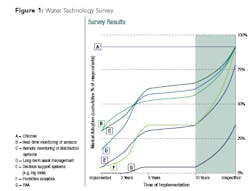LIFT Expands Role, Moves Toward ‘One Water’
By Kelsey Beveridge
The Water Research Foundation’s Leaders Innovation Forum for Technology (LIFT) has played an important role in advancing innovation for water and wastewater utilities. LIFT seeks to help combat the industry’s conservative approach to implementing new technology. It was developed by the former Water Environment & Reuse Foundation (WE&RF) and the Water Environment Federation. Following WE&RF’s merge with the Water Research Foundation (WRF) in January 2018, the new organization seized the opportunity to expand the LIFT program to incorporate drinking water — meaning LIFT now covers all aspects of water.
Technology Exposure
LIFT brings together the best scientific minds and industry specialists to accelerate adoption of innovative technologies. One of LIFT’s several objectives seeks to increase the market exposure of innovative technology providers through a Technology Scan. This is an optimal platform for technology providers to introduce their emerging, pre-commercial, or newly commercialized technologies to more than 350 of the largest water facility owners, industrial facility owners, consulting firms, and venture capitalists.
This chart depicts some results of the Water Technology Survey and marks respondent’s interest in specific technologies including chlorine, PAA, predictive analysis, remote monitoring, decision support systems, real-time monitoring of sensors, and long-term asset management. Each line in the chart represents one of the checked technologies and the collective interest in implementing the technology within a certain period.
The LIFT Technology Scan offers a three-step process that identifies and evaluates innovative technologies for the readiness level to market while providing a technical review of the inventor’s claims. Technologies range in readiness level from developing and pre-commercial to newly commercialized technologies, including those looking for their first demonstrations. The Technology Scans allow utilities interested in pilots, potential funding partners, and the WRF subscriber base to learn about the functions and merits of the technology directly from the vendor, all of which is captured in the online platform LIFT Link.
Supporting the theme of one water, LIFT Link already includes several innovative technologies that apply to both drinking water and wastewater treatment: EMAGIN’s HARVI technology and ZAPS Technologies’ LiquID Station are two examples.
EMAGIN provides water and wastewater facilities with an operational intelligence platform that supports real-time decision making when controlling critical processes. The Hybrid Adaptive Real-time Virtual Intelligence (HARVI) helps facilities reduce operational costs, enhance reliability, and prepare for emergencies. HARVI provides optimal recommendations based on 24-hour predicted system responses. For example, HARVI can help an operator know what coagulant dosage to set at a drinking water plant. One of its advantages is that it enables facility owners to design and calibrate numerical models without investing significant capital and resources. HARVI has been deployed at utility drinking water plants, wastewater treatment plants, water distribution systems, and industrial food and beverage plants.
ZAPS Technologies creates and produces online, real-time, water quality monitoring equipment to aid professionals involved in water treatment, water analysis, and environmental analysis. One of its products, LiquID Station, provides multi-parameter detection and measurement capability for varied fluid systems. Concentration measurements are determined by applying the Hybrid Multispectral Analysis approach (HMA), which uses a combination of in-situ fluorescence, absorption, and scattering measurements. It allows plants to continuously adjust their treatment based on current and online historical data records. LiquID can be applied to a wide range of water quality parameters. For example, HMA instantly identifies proteins unique to E. coli and can broadcast results every two minutes for an immediate response.
Drinking Water Initiatives
At the American Water Works Association’s 2018 Annual Conference & Exposition, WRF will launch the LIFT Drinking Water Utility Working Group. An introductory meeting will offer peer networking for utilities to share information and learn from one another, as well as prioritize technology areas for meeting the challenges in the drinking water sector.
Chuck Murray, general manager of Fairfax Water and co-chair of the Water Research Foundation, said, “LIFT has given wastewater utilities opportunities to collaborate with those who offer new technologies so as to accelerate innovation. Expanding LIFT into drinking water utilities will help advance their operations to better serve their customers.”
Although some drinking water technologies are already included in LIFT Link, LIFT expanded its Water Technology Survey in 2017 to identify additional future trends around the deployment of innovative technologies at utilities. Respondents ranked intelligent water technologies as one of the higher priorities. While some utilities have firm plans to implement intelligent water technologies within the next five years, the responses indicated that a majority of drinking water utilities are interested in the topic (see Fig. 1).
Building upon that momentum, LIFT is holding the first-ever Intelligent Water Systems Challenge. The Challenge is also supported by the American Water Works Association (AWWA), Smart Water Networks Forum (SWAN), International Society of Automation’s (ISA) Water and Wastewater Division, Cleveland Water Alliance, the Water Council, Water Technology Acceleration Project (WaterTAP), and BlueTech Research. The Challenge encourages motivated parties to work with utilities to turn data into insights. It provides students and technology professionals the opportunity to highlight their innovation with a focus on leveraging data using the best available tools to help utilities make better-informed decisions.
LIFT has experienced rapid growth since the program’s inception five years ago. Furthering LIFT’s presence in the drinking water field will help grow innovation across all aspects of water and support technology providers in their goals. WW
Editor’s Note: For more information about the LIFT program, visit werf.org/lift.
About the Author: Kelsey Beveridge is a technical writer at the Water Environment & Reuse Foundation (WE&RF), which merged with the Water Research Foundation (WRF) in January 2018.
Circle No. 299 on Reader Service Card

